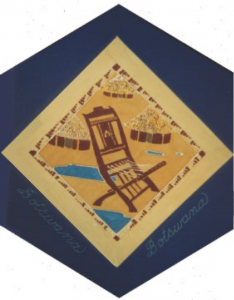Botswana

The Block
Based on a design by Sarah Trevor and created in the popular wax and dye art form of batik, the Botswana block depicts several of the country’s blessings. At the forefront is the ceremonial kgotla, or council chair, that is placed in the village’s centre and represents the traditional form of government in which all have a voice. Indeed, there is even a saying in Setswana that the highest form of war is words. Shallow puddles surround the chair, reflecting the country’s second blessing, rain. It is fitting that Pula, the Setswana word for rain, is also the name of the currency, as well as the national motto. To create the illusion of thatched roofs typically found on village huts, pale shades of yellow and brown dye intermingle with white. The intricate border pattern framing the square replicates a Ngami basket weaver’s design and pays homage to the integral part this hand-craft plays in the agricultural tradition of the country. To provide the finishing touch to this beautiful square, ornate ostrich shell beads, which have an essential place in the fabric of Botswana, are individually attached at the bottom point.
Cultural Profile
Botswana (formerly known as Bechuanaland) is the home of the Kalahari Desert and received its name from the country’s main ethnic group, the Tswana or Setswana. Other ethnicities contribute to the population of this landlocked country in southern Africa, including a small number of ‘San’ (Bushmen) who have lived in the region for many centuries. Once one of the poorest countries in the world, Botswana is now the world’s largest supplier of gem-quality diamonds. The official language is English, although the vast majority of the people speak the national language, Setswana.
Batswana are a generous, good natured people with a deep respect for the many blessings bestowed upon them. Rain, in particular, is considered a great gift, so water is never wasted and is always shared with others.
A country with an incredible amount of wildlife, including more than 70 species of snakes, Botswana also has a rich artistic history. Its traditional music differs from that of its neighbors in that it does not use drums, but rather string instruments such as the segaba, or the setinkane, the thumb piano and voice. Botswana is known for its colourful pictorial tapestries, made by women in the village of Oodi, which depict traditional scenes and stories. As well, wood carvings which are most often created by men, and blankets made with distinctive geometric patterns are also popular. It is, however, the exquisitely woven baskets that have been made for thousands of years for which the country is perhaps most famous. An average-size basket can take up to six weeks of work to complete. Each usually displays traditional designs inspired from the rich wildlife of the country.
The cuisine of Botswana is central to its cultural identity. The national dish is called seswaa. This popular dish consists of a tasty meat stew served over pap, a thick polenta. It is often accompanied by Morogo, a leafy green. Bogobe, a maize or sorghum porridge, is the food of choice for breakfast. BBQ’s are frequent and often held to mark special occasions.
Batswana, who now make up a small percentage of the Canadian population, have been coming to Canada since 1974 where they continue enjoying and sharing their communal traditions.
Sponsor: MacDougall Family
